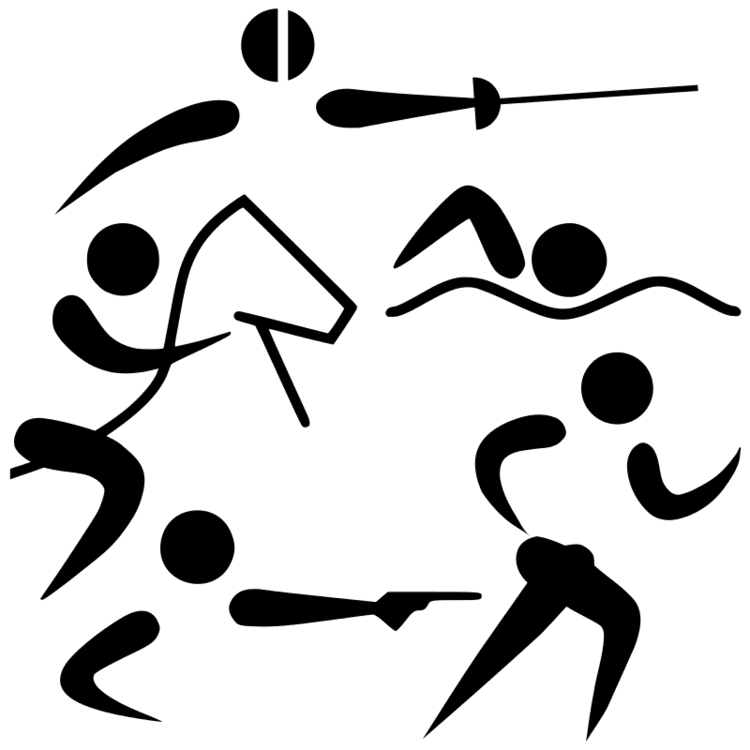 | ||
Similar Fencing, Freestyle swimming, Show jumping, Cross country running | ||
The modern pentathlon is an Olympic sport that comprises five different events: fencing, 200m freestyle swimming, show jumping, and a final combined event of pistol shooting and a 3200m cross-country run. The sport has been a core sport of the Olympic Games since 1912 despite attempts to remove it. A world championships for modern pentathlon has been held annually since 1949.
Contents
Originally the competition took place over four or five days; in 1996 a one-day format was adopted in an effort to be more audience-friendly. Modern pentathlon, despite its long Olympic history, has had to justify its inclusion in the modern Olympic Games several times. On February 11, 2013 in Lausanne, the IOC confirmed modern pentathlon once again as one of the 25 core sports of the Olympic program through to 2020. The governing body, Union Internationale de Pentathlon Moderne (UIPM), administers the international sport in more than 90 countries in all the continents of the world.
History
The foundation of the modern pentathlon is disputed. On the one hand, Baron Pierre de Coubertin, the founder of the modern Olympic Games, claimed authorship. On the other hand, Viktor Balck, the President of the Organizing Committee for the 1912 Games, showed that he made use of the long tradition of Swedish military multi-sports events, to create a manageable modern pentathlon. The name derives from the Greek péntathlon "contest of five events". The addition of modern to the name distinguished it from the original pentathlon of the ancient Olympic Games, which consisted of the stadion foot race, wrestling, long jump, javelin, and discus. As the events of the ancient pentathlon were modeled after the skills of the ideal soldier to defend a castle of that time, Coubertin created the contest to simulate the experience of a 19th-century cavalry soldier behind enemy lines: he must ride an unfamiliar horse, fight enemies with pistol and sword, swim, and run to return to his own soldiers. In the 1912 Games, with only officers competing, they were, however, permitted to use their own horses. Up to the 1952 Olympics the ordinary cavalry soldier was considered a professional athlete, as he was riding and training horses for a living, while the officer was the amateur. As long as there was no official international federation for Modern Pentathlon an IOC committee was set up for the sport making use of the expertise of IOC members.
The event was first held at the 1912 Olympic Games, and was won by Swedish athlete Gösta Lilliehöök. The modern pentathlon has been on the Olympic program continuously since 1912. A team event was added to the Olympic Games in 1952 and discontinued in 1992. After much lobby work of the President of the German Modern Pentathlon Federation Prof. Wilhelm Henze, women were for the first time admitted on a trial basis at the World Championships in San Antonio in 1977, and at the official world championships in 1981. An event for women was added in 2000. A World Championship is held every year. The competitions include Men and Women's Individual and Team event together with relay events for Men and Women and, since 2010, a mixed relay event.
Competition format
Athletes gain points for their performance in each event and scores are combined to give the overall total. This is similar to the procedure for the decathlon in track and field athletics. However, in the Modern Pentathlon, starting times for the last event (cross country running before 2009; combined laser pistol shooting and cross-country running since 2009), are staggered so that the first person to cross the finish line is the winner. Before the last event competitors are ranked according to their score from the other disciplines and given start times accordingly, with the leader going first, and other starting times being dependent on the number of points already scored. The first person to cross the finish line, therefore, will be the overall points leader and win the pentathlon. This method of finishing the competition would also eventually find use in winter events; the Gundersen method details a means by which a similar finish is achieved in the Nordic combined.
The combined event is similar to the biathlon at the Winter Olympic Games, which combines cross-country skiing with rifle shooting. However, whereas biathletes carry their rifles while skiing, pentathletes do not carry their pistols while running. The change has been criticized as altering too radically the nature of the skills required. The New York Times asked whether the name ought to be changed to "tetrathlon" given that two of the five disciplines had been combined into a single event.
In the new format, in each of the four rounds of firing, athletes have to successfully shoot five targets, loading the gun after each shot. They may resume running once they have five successful hits, or once the maximum shooting time of 70 seconds has expired. Misses are not penalised. The new format maintains the principle that the overall winner will be the first to cross the finish line.
